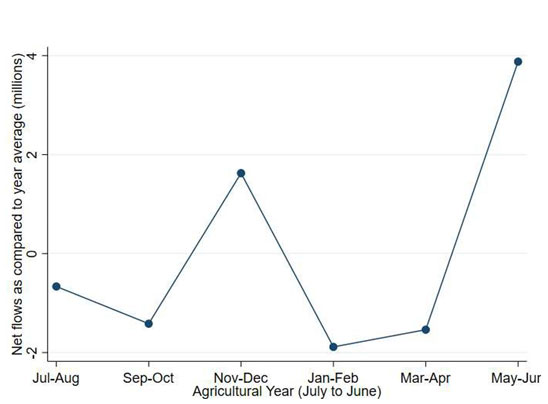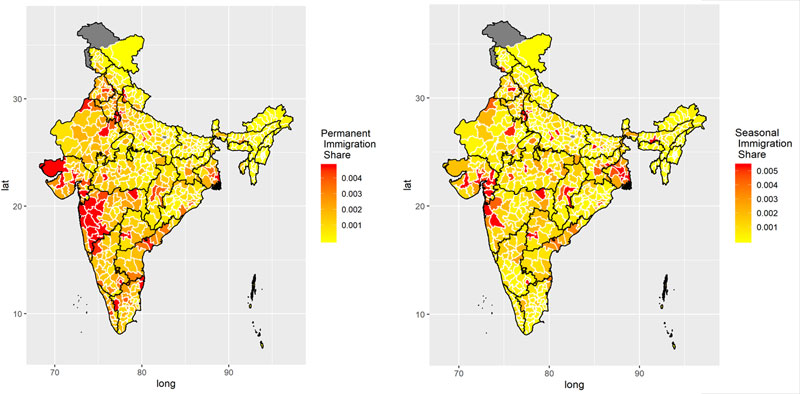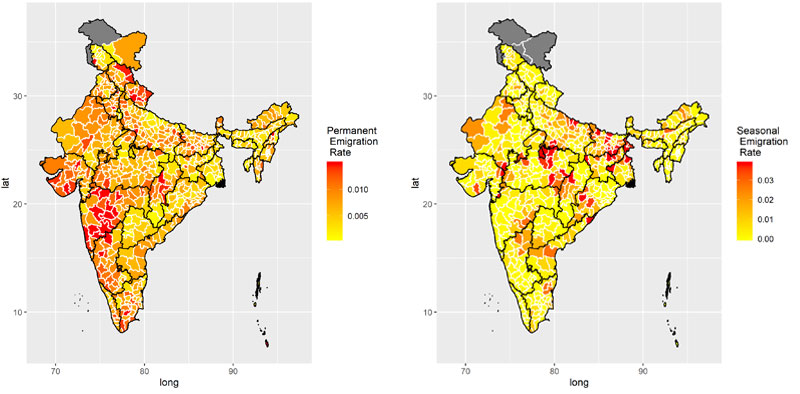Since the lockdown was announced in India, many migrants have undertaken the difficult journey to their place of origin. However, millions of them are still in urban areas, and some are expected to return home when the lockdown is lifted. Using past data on seasonal and permanent migration, Imbert shows that these will mostly come from a few manufacturing clusters where Covid-19 prevalence is high, and return to poor rural areas where healthcare capacity is low.
Since 24 March 2020, when the lockdown of India was announced, many migrant workers have been without work, and were prevented to go home. Without support from their family and networks back home, they have to rely on government assistance for food and shelter. The plight of migrants gathered in camps, protesting at train stations, or walking hundreds of kilometers to go home, has moved the nation and the world. After 3 May, once restriction on mobility are lifted, some of them are expected to return home. This return migration poses the risk of carrying the virus to rural areas with poor public health provision.
The objective of this note is to answer three simple questions: (i) How many migrants will return home? (ii) Which districts will returning migrants come from? (iii) Which districts will returning migrants go to?
Migrants are always difficult to track. I will use the most recent data available.
- Census 2011 on permanent migration.
- National Sample Survey (NSS) Employment-Unemployment Survey 2007-08 on seasonal migration.
- Census 2001 district-to-district migration matrix to guess which districts permanent migrants are from and which districts seasonal migrants go to (as in Imbert and Papp 2020).
- Monthly total of unreserved (general) class trips in 2014-15 from the Indian Railways (Firth and Imbert 2020).
How many migrants will return home?
To know how many migrants will go home, we need to know how many migrants there are, and what fraction of them will go home once mobility restrictions are lifted.
Permanent migrants are people who changed their residence. From Census 2011 we know that in the year preceding the Census, 8 million people had moved to another district within their state, and 4 million to another state. The question is how many of these permanent migrants will go back? Many of them have a house, a family, and a livelihood where they currently are. They may be tempted to go home if their livelihood is compromised, but given the current uncertainty they may also prefer to wait until autumn.
Seasonal migrants are those who go away to work when there is less work to do at home. From NSS Employment Survey 2007-08, we know that between July 2007 and June 2008, 10 million people spent one to six months away from home for work in another district, and 6 million in another state.
These figures are for a whole year, but seasonal migrants are typically gone for a few months only. The question then is: how many seasonal migrant were away at the time of the lockdown (24 March)? To shed light on the timing of seasonal migration, I use Indian Railways data (Firth and Imbert 2020). Bi-monthly net flows from rural to more urban stations show outflows in November-December (after the Kharif1 harvest), a reflux in January to April (for the Rabi2 harvest), and major outflows in May-June.
Figure 1. Seasonality of railway passenger flows
To sum up, and rescaling numbers to account for population growth, there may be up to 22 million migrants who will go home when the lockdown is lifted. Assuming that many intra-state migrants were able to go home already, the numbers will be closer to 11 million, the number of interstate migrants. But the numbers are likely to be even lower, as a majority of permanent migrants will stay at destination, and a majority of seasonal migrants may actually be still at home for the Rabi harvest.3
Where will migrants return from?
To know where migrants currently are, I use the Census 2011 for permanent migrants, and NSS Employment Survey 2007-08 combined with Census 2001 for seasonal migrants4.
Figure 2. Share of total permanent migrants (left) and share of total seasonal migrations (right) going to each district of destination
The two maps in Figure 2 paint relatively similar pictures. Permanent migrants who return will come from the main urban centres of India (for example, Ahmedabad, Bangalore, Chennai, Delhi, Mumbai), as well as from manufacturing clusters (such as in Gujarat and Maharashtra). Seasonal migrants are even more concentrated geographically, which reflects the fact that they tend to go and look for work in construction in the largest urban centres (Imbert and Papp, forthcoming).
There are two things to learn from the concentration of migrant in a few destinations. In the short run, as migrants return from places where Covid-19 is the most prevalent at the moment (Delhi, Gujarat, and Maharashtra)5, the risk that they disseminate the virus is high. In the long run, if migrants go home and do not come back (for example, if they wait until November), destinations will experience severe labour shortages. Previous evidence from the drop in seasonal migration due to MNREGA6 (Mahatma Gandhi National Rural Employment Guarantee Act) suggests that urban centres depend heavily on migrants for their casual labour (Imbert and Papp 2020).
Where will migrants return to?
To know the districts permanent migrants will return to, I use Census 2011 combined with Census 2001. For seasonal migrants, I use NSS Employment Survey 2007-087.
Figure 3. Permanent migration rate (left) and seasonal migration rate (right) coming from each district of origin
The picture presented by the two maps in Figure 3 is quite different. To the left, permanent migration is relatively spread out across states. To the right, seasonal migration is concentrated geographically in remote rural areas in some of the poorest states of the country (Bihar, Chhattisgarh, Jharkhand, Madhya Pradesh, and Odisha). This means that when seasonal migrants go home, the responsibility of providing them with healthcare or quarantine them will fall on a small number of districts which are poor and remote to start with.
Key takeaways
- Up to 22 million migrants (11 million interstate) may go home when the lockdown is lifted. But the actual numbers are likely to be much lower.
- Returning migrants will come from a few urban/manufacturing clusters where the prevalence of Covid-19 is currently high.
- Returning migrants will go back to poor and remote rural areas where the capacity to provide healthcare and quarantine them is low.
The author is grateful to John Firth, Anup Malani, Rohini Pande, Chinmay Tumbe for comments.
Notes:
- Crops that are sown during the monsoon season in India and harvested in autumn.
- Winter crops that are grown in the month of October or November, and harvested in spring.
- I did not make any distinction between male and female migrants, although many female migrants are married and would not go back to their own family, but to the extent that migrants marry migrants, women are equally likely to go back to their in-laws as men to their parents.
- The data can be found on the Devdatalab repository https://github.com/
devdatalab/covid. - See updated numbers from the Ministry of Health and Family Welfare https://www.mohfw.gov.in/index.php.
- MNREGA guarantees 100 days of wage-employment in a year to a rural household whose adult members are willing to do unskilled manual work at state-level statutory minimum wages.
- The data can be found on the Devdatalab repository https://github.com/
devdatalab/covid.
Further Reading
- Firth, J and C Imbert (2020), ‘Seasonal Migration: Evidence from Indian Railways’, Manuscript.
- Imbert, Clément and John Papp (2020), “Short-term Migration, Rural Public Works, and Urban Labor Markets: Evidence from India”, Journal of the European Economic Association, 18(2):927-963.
- Imbert, Clément and John Papp (forthcoming), “Costs and Benefits of Seasonal Migration: Evidence from India”, Journal of Development Economics.




 01 May, 2020
01 May, 2020 







By: Karthi 02 May, 2020
Nice blog post.Also visit financial balance in lockdown